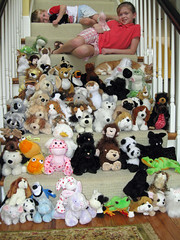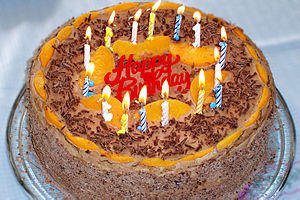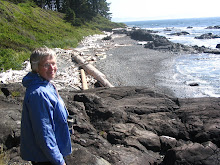 Image by oosp via Flickr
Image by oosp via Flickr
I asked about Facebook. James told me that anyone can use Facebook. He considers it a really girlie site. He demonstrated how the girls would hold their cameras out in front of them and "take about sixty pictures a day and then put them on their site". (I had to laugh because I have seen sites like that.)
I asked James about Twitter. He said he had heard of it but wasn't sure who was using it. It's not popular among younger students.
James said that 99% of his computer learning has come at home. They hardly teach you anything at school. (For myself as a teacher, this points up the importance of teaching computer use at school for those who do not have a computer or internet access at home. If James had no computer at home, how computer literate would he be?)
 Image via Wikipedia
Image via Wikipedia
James and my son talked about how from kindergarten to about Grade 6, computer use and game playing is accepted by your friends. However, past Grade 7 or so, if you are on the computer all the time, you are seen as a nerdy thing, a geek. The non-Nerds go on Face Book, YouTube or chat or messaging. Use of FaceBook is seen as suave or cool.
James' final comment was "It's kind of like the Wild West out there." Since this impromptu interview took place on July 10th, I have forgotten the context for that last comment. I don't know whether it was in regards to the rapid pace of change in technology or to the use of YouTube with his friends.
Since this interview, I have mulled over James' comments quite often. This week as I have read many articles about social networking sites, few have highlighted gender differences in usage of many sites. There have been age group differences pointed out but not gender differences. I wonder what difference gender makes in decisions about which sites to frequent.
My perceptions are that the majority of FaceBook users are girls and women. This is based on my FaceBook account in which most of the friends in my network are women. Women are the most active. Many of my friends post pictures and personal news very regularly. I had one friend tell me that she rarely checks her email anymore because she uses her Facebook account to communicate with her friends. I also visit my older son's Facebook account once a month. It rarely changes. My daughter changes her site at least once each week.
My perception is that the majority of Twitter afficionados are men. This is based on the people I am following on Twitter who are most active with tweets and updates--it's the men. As well, it seems to be men older than 25 years old. However, one idea I came across on the internet was that, in this era of easy text messaging over the phone lines, younger people will gradually warm up to the idea of sending short message bursts as you do on Twitter. (I realize that Twitter is the topic of the next blog entry. However, it is used by many people as a social networking site.)
At the Hitwise website, they listed the top 20 websites for Social Networking for th
 Image by M.V. Jantzen via Flickr
Image by M.V. Jantzen via Flickr
It is interesting to see Club Penguin come in as the sixteenth most visited social networking site. Richardson (2009, p. 6) calls children's social networking sites' "Club Penguin and WebKinz--social networking sites with training wheels."
WebKinz, which is online at http://www.webkinz.com/us_en/, is a site for children ages 6 to 13 that is hosted by the Ganz company. WebKinz are stuffed animals which have a web code to enter on the WebKinz site. The code allows a child to receive 2000 KinzCash to buy things at the WebKinz site. (Since I did not purchase a WebKinz in order to try this site out, I had to guess at how it worked.) Last year when I taught grade one and two, I had a show and tell time once each week. Almost every week, one of my students brought a new WebKinz toy to school. So I am sure that many of my students were going on this site regularily. When I realized in my reading that WebKinz is a social networking site, I was shocked. I didn't realize that children were getting started in social networking so early.
I explored the parent area of WebKinz. There are ads at this site although parents can assist their children to turn the ads off for 30 days. Children can chat at this site on KinzChat. However they can only use the phrases provided. There is a version for ages 10 and up which allows more freedom of language. However, parents must approve before a child can receive this KinzChat Plus account. Many words are disallowed (e.g. boyfriend). Numbers are disallowed so that children do not give personal information such as telephone numbers or street addresses. Words must be spelled correctly to be accepted. They suggest that parents monitor the messages
 Image by Erik Eckel via Flickr
Image by Erik Eckel via Flickr
Parents are encouraged to manage their child's time. When child is not on the computer, encourage them to play with their Webkinz and have Webkinz parties. When the child is at the WebKinz site, he or she can learn: fun facts at Quizzy's, addition skills, how to type and spell, how to think logically, reading, writing, creativity, and problem-solving. When the child earns KinzCash, he or she learns about money--how to save and spend it. The child learns how to be responsible, take care of pets, how to get along with others.
I found this site to be very commercial. The child needs to buy a WebKinz (stuffed animal) in order to have a code to go on the site. The child is encouraged to purchase more WebKinz to have more fun and earn more Kinz cash. I don't think this would be a social networking site for students to use at school. However, safeguards and teaching about privacy and even advertising monopolies might be good to discuss even with grade 1 and 2.
The other site mentioned by Richardson as social networking with training wheels was Disney Club Penguin. This is the site that came in sixteenth on the number of users for the week ending July 25, 2009. This site is sponsored by Disney and allows no third party advertising (Does this mean that Disney is allowed to advertise?). On this site 6 to 14 year-old students create a virtual world. The basics are free but memberships give you additional privileges. One month costs $5.95 Cdn plus GST; six months costs $29.95 Cdn plus GST; and one year costs $57.95 Cdn plus GST. (If one is purchasing memberships in American dollars, membership cards may be picked up at Target, Walmart, Toys r Us, and Best Buy. This is significant because it reveals the commercial networks behind this site.)
At Club Penguin, children are able to: practice reading, learn keyboarding, do creative role playing, spend virtual money, practice math and money management, develop social skills as part of a community. Parents can set Play Hours (e.g. from 4:00-4:45 p.m.) and li
 Image via Wikipedia
Image via Wikipedia
In a similar way to WebKinz, Club Penguin has a Ultimate Safe Chat in which children use only phrases which are supplied for them. There is a Standard Safe Chat which is moderated by an online, human moderator. One mother wrote in that her son learned a lesson when he was suspended from the Chat because he used a swear word.
Club Penguin had some excellent safety ideas for children online. They asked parents to go over the safety rules with their children. These are the precautions they suggest:
- Never give out personal information, such as your real name, age, location, phone number or school.
- Never share your password with anyone except your parents. Someone else might use your password and pretend to be you, give out your personal information or do something that may get you into trouble.
- Tell your parents if someone says or does something on the Internet that makes you uncomfortable, or if someone asks you for personal information.
- Choose a username that does not reflect your real identity. Avoid names that are in any way suggestive, even if they seem innocent to you.
- Avoid chat rooms that are not monitored by moderators. (Link)
I found both of these sites quite materialistic. Children get dollars that they can spend at the store. Both sites are sponsored by businesses (Ganz and Disney) which want to make money. Both are popular with children. Thus the children are imbibing the concept that more and bigger and newer is always better. Again, this is where teachers could teach about advertising and influence and being a critical thinker.
I can't see teachers in the younger grades using sites like WebKinz or Club Penguin in school. However, teachers can certainly develop concepts for safety online with students. Possibly schools should offer workshops for parents in recognizing underlying values of various websites where their children are active.
I discovered some watchdogs that were attempting to keep websites for children and others accountable for good ethical choices. View the Better Business Bureau's Online ratings for online businesses at http://www.bbb.org/online/consumer/Relbrowse.aspx Unfortunately this list is not in alphabetical order except by the first letter in the word. Penguin Club is certified by them. There are 55,830 online sites are accredited by the Better Business Bureau.
Trust E is another site guaranteeing privacy of online sites (http://www.truste.com/privacy_seals_and_services/consumer_privacy/). At this site, they provide recommendations for keeping passwords and IDs safe and tamper-proof. They also give a tutorial for parents, teachers, and children about onine privacy. This is a PDF file which discusses ethics, safety, online addictions, privacy, and security issues. I Keep Safe.org is another website with lots of information for teachers to use with students (http://www.ikeepsafe.org/iksc_educators/)
At that I Keep Safe site they suggest that for elementary students the key ideas are: "Keep Safe • Keep Away • Keep Telling
1. I keep safe my personal information—all of it! I never give my real name, address, phone number, the name of my school, or a picture of myself to anyone online.
2. I keep away from Internet strangers—no matter what they tell me, because I have no way of knowing who they really are. I don’t talk with them online, and I never meet them face-to-face.
3. I keep telling my parents about everything I see on the Internet—especially when something makes me uncomfortable."
At I Keep Safe.org the middle and high school guidelines are: "Protect your NAME, IDENTITY, and REPUTATION". For these students, things they post online today can leave an indelible mark for the future. This could affect achievement of their life goals. Since students in this age group listen to their peers, peer materials have been developed for presentation within peer-to-peer educational modules. Check out their videos at http://www.ikeepsafe.org/PRC/videotutorials/index.php Image via Wikipedia
Image via Wikipedia
There may be some ways to use social networking sites with students at school. Nings would be one option. A ning is a social networking site that can be private and available by invitation only. It may also be public so that anyone can join. Once you are inside the ning, it operates much like Facebook with groups, news, and even birthday greetings. The ning is free but it comes with built-in advertising. If you want the ads turned off, that will cost money. Starting in December 2008, ning disallowed adult sites. They found that they were receiving so many copyright violation notices that it was too much trouble. So they gave those sites quite a bit of notice and they had to vacate the premises.
You can create your own ning--giving it a name and creating a moniker for a website that will end in ning.com. You can explore the list of nings which have already been created. When I looked around at the ning site, I typed in Saskatoon and eight ning sites came up. Four were private and four were public so I could join. The two I looked at were not very active.
When I typed in Canada, there were 527 ning sites. The Alberta Virtual Classroom Ning had 12 new members join in the last year. http://albertavirtualclassroom.ning.com/
One of the library nings is Library 2.0, created by Bill Drew http://library20.ning.com/ That ning has 4,331 members. Joyce Valenza's Teacher Librarian Ning had 3,453 members and 9 members joined in the last week (probably mostly from our class) http://teacherlibrarian.ning.com/ This was a very active and comprehensive site. There was even an Animoto video to watch. There was lots of news, job postings for librarians, and many great teaching videos. I decided to join this site. However, I noticed a message at the very bottom of the page. It was from the founder of this ning, Joyce Valenza.
"Hi friends,
(Update: I am now approving membership. If you plan to join, please identify yourself as a legitimate member of the library or related field in your profile.)
Over the past week or so, our network has been hit by spammers. I have blocked several and wrote to the Ning people about others. This is happening on the other Nings too. Please hang on while I work through the problem. I am very sorry.
joyce"
This shows me that even well-established nings can run into spamming troubles. I did receive an email today accepting me into the ning.
Now, how could a teacher use a ning with students. A teacher could create a class ning as a private, social network. A discussion group could be set up. Literature circle work could take place on the ning. Peer writing and editing could take place on the ning. For teachers in high schools, each class period could have its own ning. Groups could also be set up according to students interests. Those students interested in the school newspaper could have their own ning. They could have alternative book clubs, readings logs or journals, and nings providing information for parents and families. The advantage of a ning over a Facebook group would be more privacy, no spillover of information. A ning (even one in which anyone is invited to join) can be set up so that an administrator needs to approve new members. (Just as Joyce Valenza needed to approve my request to join her ning.) One commenter suggested the use of Moodle rather than a ning to set up a private social network for a class. I'm not familiar with Moodle although I understand that it is similar to the Blackboard application which this class uses for our eclass host. Another writer said that a class ning is better than a class wiki since more than one person can edit a page at the same time.
In closing this very long blog post, I wish to describe how I would use a ning with a biography unit in Grade 5. I actually call it a Life Stories unit. I have taught this unit several times with a Grade 5 class. Each student chooses one person to learn about. They read books and do internet searches to learn more about that individual. Then they find 15 life events, type those in jot note form, and glue them on a timeline. Then I, the teacher, match up students so that their famous persons have overlapping timelines. Students use their paper timelines to discuss important life events and world events for their biography subjects. (I forgot to mention that I place students in groups of four.) In the past, I have asked students to then create a conversation between their four subjects. They need to somehow display the interaction (all imaginary since the people likely never met in real life), which could take place between their four people. In the past, I had one group that made a movie including all four people. Another group presented a literature theatre including all four. The next time I do this unit, a ning could be another way to present their subjects. Each one would take on that persona. They could create data which they would build into the ning to describe and flesh out the picture of that person. Then they would interact with the other famous people on their ning. One could even have all of the biography subjects, remaining in character, interacting with the network of others at the ning site.
I guess my bottom line with students and school and social networking sites is that schools should be partnering with parents to teach safety in online use. Except for the possibility of setting up a class ning, I don't see this as being a tool I would feel comfortable using with elementary children at school.
References:
Personal interview with James (pseudonym). (10, July 2009).
Richardson, W. (2009). Blogs, wikis, podcasts, and other powerful web tools for classrooms. Thousand Oaks, California: Corwin Press.
![Reblog this post [with Zemanta]](http://img.zemanta.com/reblog_e.png?x-id=8ba75be9-d36c-4172-8075-f2bfef25b65d)





Hi Ruth,
ReplyDeleteWhat a great way to get the "scoop" on teenagers use of the internet - an interview. Good thinking!
I have quite a few male "friends" on Facebook, many of which post their happenings & pictures just as much as their female counterparts & participate in applications & games just as much too. Maybe my friends are just more active Facebook users????
Thanks for sharing some great information & insights.
Hi Carol,
ReplyDeleteI realize that my findings on Facebook are very informal. I may also be in a different age category from you so that my friends are using technology in a different manner from the way yours are using it. This morning at my bed and breakfast, at our breakfast together with the owners and the other guests, we had an interesting conversation about the use of technology. The other guest couple were a wife who uses the computer mainly for email and the husband who does not use the computer at all. They are in a generation a decade or so beyond my generation.
There are many layers and depths to understanding the computer use. There is the generational overlay, then the gender overlay, and possibly even the education overlay (would those with a university degree uses technology in a different manner?
Ruth).